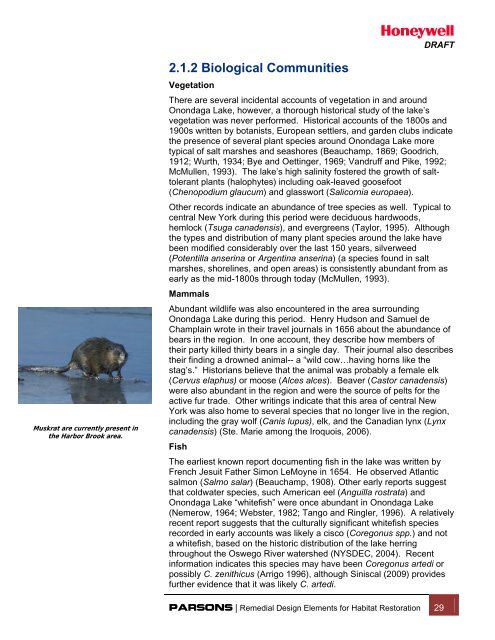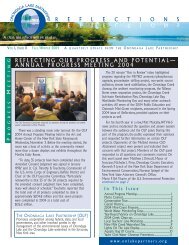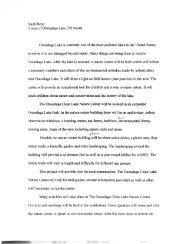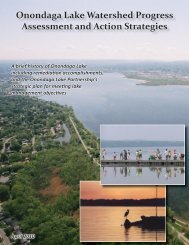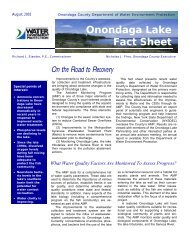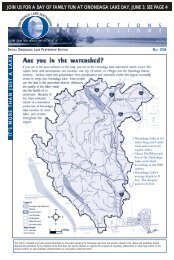Habitat Plan 2 - Onondaga Lake Partnership
Habitat Plan 2 - Onondaga Lake Partnership
Habitat Plan 2 - Onondaga Lake Partnership
You also want an ePaper? Increase the reach of your titles
YUMPU automatically turns print PDFs into web optimized ePapers that Google loves.
DRAFTMuskrat are currently present inthe Harbor Brook area.2.1.2 Biological CommunitiesVegetationThere are several incidental accounts of vegetation in and around<strong>Onondaga</strong> <strong>Lake</strong>, however, a thorough historical study of the lake’svegetation was never performed. Historical accounts of the 1800s and1900s written by botanists, European settlers, and garden clubs indicatethe presence of several plant species around <strong>Onondaga</strong> <strong>Lake</strong> moretypical of salt marshes and seashores (Beauchamp, 1869; Goodrich,1912; Wurth, 1934; Bye and Oettinger, 1969; Vandruff and Pike, 1992;McMullen, 1993). The lake’s high salinity fostered the growth of salttolerantplants (halophytes) including oak-leaved goosefoot(Chenopodium glaucum) and glasswort (Salicornia europaea).Other records indicate an abundance of tree species as well. Typical tocentral New York during this period were deciduous hardwoods,hemlock (Tsuga canadensis), and evergreens (Taylor, 1995). Althoughthe types and distribution of many plant species around the lake havebeen modified considerably over the last 150 years, silverweed(Potentilla anserina or Argentina anserina) (a species found in saltmarshes, shorelines, and open areas) is consistently abundant from asearly as the mid-1800s through today (McMullen, 1993).MammalsAbundant wildlife was also encountered in the area surrounding<strong>Onondaga</strong> <strong>Lake</strong> during this period. Henry Hudson and Samuel deChamplain wrote in their travel journals in 1656 about the abundance ofbears in the region. In one account, they describe how members oftheir party killed thirty bears in a single day. Their journal also describestheir finding a drowned animal-- a “wild cow…having horns like thestag’s.” Historians believe that the animal was probably a female elk(Cervus elaphus) or moose (Alces alces). Beaver (Castor canadensis)were also abundant in the region and were the source of pelts for theactive fur trade. Other writings indicate that this area of central NewYork was also home to several species that no longer live in the region,including the gray wolf (Canis lupus), elk, and the Canadian lynx (Lynxcanadensis) (Ste. Marie among the Iroquois, 2006).FishThe earliest known report documenting fish in the lake was written byFrench Jesuit Father Simon LeMoyne in 1654. He observed Atlanticsalmon (Salmo salar) (Beauchamp, 1908). Other early reports suggestthat coldwater species, such American eel (Anguilla rostrata) and<strong>Onondaga</strong> <strong>Lake</strong> “whitefish” were once abundant in <strong>Onondaga</strong> <strong>Lake</strong>(Nemerow, 1964; Webster, 1982; Tango and Ringler, 1996). A relativelyrecent report suggests that the culturally significant whitefish speciesrecorded in early accounts was likely a cisco (Coregonus spp.) and nota whitefish, based on the historic distribution of the lake herringthroughout the Oswego River watershed (NYSDEC, 2004). Recentinformation indicates this species may have been Coregonus artedi orpossibly C. zenithicus (Arrigo 1996), although Siniscal (2009) providesfurther evidence that it was likely C. artedi.PARSONS | Remedial Design Elements for <strong>Habitat</strong> Restoration 29


